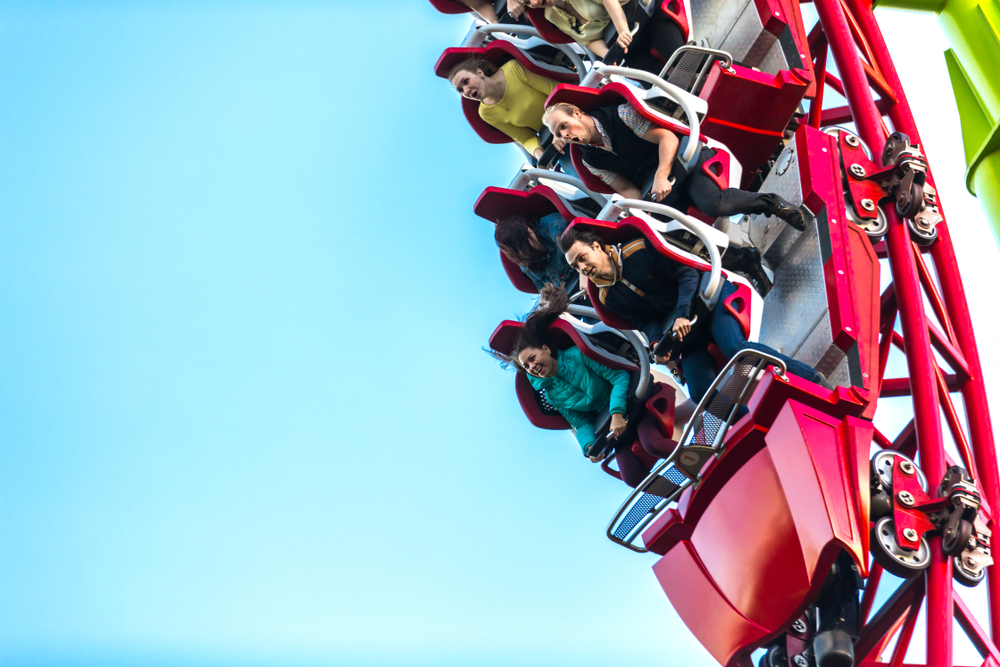
When roller coaster at Coney Island first debuted in 1884, thrill seekers climbed aboard a ride that climbed a 15-foot hill and sped four miles per hour.
Modern coasters can reach heights of 300 feet and speeds of 90 miles per hour. They drop riders suddenly or bring them back. Riders twist, fly upside down and return to the start in just minutes.
Scientists are learning more about what happens to the body during a roller coaster ride. Bends are harmless for most people. But for a select few, the experience can be risky.
Sudden stops
Roller coaster harnesses are designed to hold riders in place and keep them from falling off the ride. But the head and neck can still move freely, and quick starts and sudden stops can cause excessive movement in the neck (hyperextension) and neck joints (hyperflexion).
These sudden movements can leave some riders with whiplash. In rare cases, neck movements can lead to cervicocephalic arterial dissection and then a stroke. This particular type of stroke is difficult to diagnose because the main complaints – headache and neck pain – are associated with many other conditions.
In one medical case study, an 11-year-old boy experienced a sudden headache when the roller coaster he was riding suddenly stopped. He fought through the pain and rode several other rides that day. Over the following weeks, the headache remained and his symptoms progressed to dizziness, nausea and vomiting.
Computed tomography showed that the boy had a stroke. The boy was treated with anticoagulants and made a full recovery. The case study authors note that this type of roller coaster reaction is rare, and they only have a record of it happening about twice a year.
Heartbreaking drops
The thrill of roller coasters can make a person’s heart skip a beat. The human body it releases neurochemicals like dopamine and adrenaline and the experience can be exhilarating and exhilarating. Studies have found that such excitement can lead to palpitations and arrhythmias.
In 2007 research paper to JAMA, a group of German scientists describe how they asked volunteers at an amusement park to wear a 12-lead Holter electrocardiogram while riding a roller coaster. Fifty-five people agreed. All were over 18 years of age and none had a known history of heart disease.
The volunteers wore the electrocardiogram five minutes before the ride so the researchers could measure their resting heart rate. When the coaster started moving, the volunteers pressed a button that recorded the start of the ride. After the ride was over, they left the EKG on for another five minutes.
The ride began with a 30-second hill climb to a terrifying 203 feet, followed by a four-second free fall. Then, with 82 seconds remaining, the trip went as fast as 74 miles per hour. It went up and down six more hills and followed sharp, sudden turns.
Not surprisingly, the volunteers showed a spike in heart rate and blood pressure. However, the highest heart rate levels occurred in the first 30 seconds as the ride climbed the first incline and riders anticipated the coming drop.
During the initial tilt, one subject had an arrhythmic episode that resolved on its own. One person had four seconds of atrial fibrillation at the end of the ride, including palpitations, which also went away on their own. Forty-four percent of the participants had asymptomatic sinus arrhythmias within five minutes of finishing the ride.
The authors concluded that the volunteers had benign cardiac responses, but people with underlying heart disease were at risk for arrhythmic episodes.
Read more: How a heart can stop after a big blow
Super speeds
As scientists learned more about traumatic brain injury (TBI), they wondered if the strong gravitational forces of roller coasters could cause it. 2009 study in The American Journal of Forensic Medicine and Pathology recruited volunteers to ride three roller coasters at Six Flags.
Four people agreed to participate – two adults in their twenties and two children aged 11 and 13. Volunteers bit into a mouth plate with sensors for each activity. Sensors recorded their movements on the coasters as they flew at speeds of up to 85 miles per hour and zoomed through loops, drops and other nasty elements.
The authors compared head movements for each activity and found that there was a low risk of TBI from a roller coaster. Roller coasters have an average head injury criterion (HIC15) of 4.1, which is six times less than what a person would experience in a TBI-induced car accident. Likewise, the head impact coefficient (or HIP) is .36 on a roller coaster, compared to a 3.41 HIP from a car crash.
in 2017 similar research in Journal of Neurotrauma found little evidence that roller coasters can lead to TBI. But the authors also caution that even though the risk is low, scientists don’t fully understand what the brain’s trains do or don’t do.
Read more: Traumatic brain injuries in children, especially girls, show a 20-year increase

